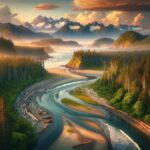Washington State’s Majestic Elevation: Exploring the Evergreen State’s Remarkable Heights takes us on a captivating journey through the awe-inspiring elevation of Washington state. With its towering peaks, expansive valleys, and impressive plateaus, this corner of the Pacific Northwest boasts a landscape that is as diverse as it is breathtaking. From the rugged slopes of the Cascades to the rugged beauty of the Olympic Peninsula, this article delves into the remarkable heights that make Washington state a natural wonderland for adventurers and nature enthusiasts alike.

Key Takeaways:
- Washington is the second most populous state on the West Coast and in the Western United States, after California.
- Mount Rainier, the state’s highest elevation, reaches 14,411 feet (4,392 meters) and is an active stratovolcano.
- Mount Rainier is the most topographically prominent peak in the contiguous United States.
- The lowest point in Washington is at sea level where it meets the Pacific Ocean in the west.
- The average elevation of the state of Washington is approximately 520 meters.
- The elevation of Washington greatly influences its climate, with higher elevations experiencing cooler temperatures and more precipitation.
- Washington is located in the Pacific Northwest region of the Western United States.
- The state’s geography is diverse, featuring mountains, forests, and coastal areas.
- Washington was formed from the western part of the Washington Territory, ceded by the British Empire in 1846.
- Washington is bordered by Canada to the north and Oregon to the south.
Elevation of Washington State
Washington state, known as the Evergreen State, is a geographic wonderland with diverse landscapes that captivate the imagination. From the towering peaks of the Cascade Range to the lush valleys and coastal areas, this state’s elevation has a profound influence on its climate and scenery.
Exploring the Varying Elevations
One of the most striking features of Washington state is its range of elevations. With an average elevation of approximately 520 meters, the state offers a variety of high and low points that shape its topography. Let’s delve into some of the noteworthy elevations within Washington.
Mount Rainier:
Standing tall at 14,411 feet (4,392 meters), Mount Rainier is the highest peak in Washington state. This active stratovolcano not only holds the title of the state’s highest elevation but also boasts the most topographically prominent peak in the contiguous United States. Its majestic presence dominates the horizon, showcasing the state’s dramatic natural beauty.
Coastal Areas:
While the coast may bring to mind images of sandy beaches and the vast ocean, the elevation of Washington’s coastal areas is at sea level. This lowest point in the state is a stark contrast to the towering mountain ranges found inland. The meeting point of Washington and the Pacific Ocean in the west gives visitors a chance to experience the tranquil harmony between land and sea.
Influence on Climate
The elevation of Washington state plays a crucial role in shaping its climate. As you venture to higher elevations, cooler temperatures and more precipitation greet you. The region’s weather patterns undergo significant shifts due to the variation in elevation. Prepare for a refreshing change in climate as you ascend into the mountains or explore the elevated plateaus.
Unique Geography of Washington
Washington’s diverse geography is a testament to its remarkable elevation ranges. From the snow-capped peaks of the Cascades to the dense forests and picturesque valleys, the state’s topography is a haven for outdoor enthusiasts and nature lovers. The clash of mountains, forests, and coastal areas creates an enchanting tapestry that never fails to leave an indelible mark on visitors.
Final Thoughts
In exploring the elevation of Washington state, we uncover a tapestry of extraordinary heights and valleys. From the soaring peaks of Mount Rainier to the coastal areas that meet the Pacific Ocean, each elevation contributes to the state’s unique geographical splendor. Whether you seek adventure in the mountains or a tranquil escape along the coast, Washington’s remarkable heights offer an experience unlike any other.
Note: For more detailed information, please refer to the sources provided.
Sources:
- Washington (state) – Wikipedia. Link
- Washington Physical Map and Washington Topographic Map – Geology.com. Link
Here are some captivating sentences with active internal links:
- The highest elevation in Arkansas will take your breath away. Don’t miss the opportunity to explore it! Check it out here.
- Discover the lowest point of Florida, a fascinating natural wonder waiting to be explored. Experience it for yourself by clicking here.
- Are you curious about the elevation of Kansas? Click here to uncover the fascinating details.
- Witness a breathtaking sunrise at Niagara Falls, a truly magical experience. Plan your visit by clicking here.
- The tallest point in Ohio offers stunning panoramic views that will leave you in awe. Click here to find out more.
- Behold the magnificent Royal Clock Tower, a symbol of elegance and grandeur. Discover its beauty by clicking here.
Variation of Elevations in Different Regions
Washington state is a geographical marvel, with its diverse landscape showcasing a variation of elevations in different regions. From the coastal areas to the towering peaks of Mount Rainier, the state’s topography offers breathtaking sights and unique experiences. Let’s explore the remarkable heights found across Washington state.
The Cascade Range: Majestic Peaks and Valleys
One of the most prominent features of Washington state’s elevation is the Cascade Range. This mountain range runs north to south, bisecting the state and shaping its geography. With a collection of majestic peaks and deep valleys, the Cascade Range showcases the diverse elevation profile of Washington.
The highest peak in the state, Mount Rainier, stands tall at 14,411 feet (4,392 meters). Not only is Mount Rainier the highest point in Washington, but it is also the most topographically prominent peak in the contiguous United States. This stratovolcano’s snow-capped summit is a sight to behold, attracting adventurers and nature enthusiasts from around the world.
Coastal Areas: A Contrast in Elevation
While the Cascade Range dominates the eastern portion of the state, the coastal areas of Washington offer a contrasting landscape. These areas lie at sea level, presenting a stark contrast to the mountainous regions inland.
As you make your way towards the Pacific Ocean, you’ll witness the gradual transition from higher elevations to sea level. The elevation gradually decreases, providing a unique perspective on the state’s topography.
Influence on Climate and Geography
The variation in elevation across Washington state significantly influences its climate and geographical features. Higher elevations often experience cooler temperatures and more precipitation, contributing to the state’s diverse climate patterns.
This diverse geography, shaped by varying elevations, includes not only snow-capped peaks but also dense forests, tranquil valleys, and picturesque coastal areas. The elevation changes within the state give rise to an enchanting landscape that captivates visitors and locals alike.
Key Takeaways:
- Washington state boasts a remarkable variation of elevations in different regions.
- The Cascade Range, running north to south, features majestic peaks and valleys.
- Mount Rainier, at 14,411 feet (4,392 meters), is Washington’s highest and most prominent peak.
- Coastal areas offer a contrast in elevation, lying at sea level.
- The state’s elevation influences its climate, with higher elevations experiencing cooler temperatures and more precipitation.
- Washington’s diverse geography, shaped by varying elevations, encompasses snow-capped peaks, dense forests, valleys, and coastal areas.
Sources:
– Topographic Map of Washington
– Geography of Washington (state)
Significance of Elevation Changes in Washington State
The diverse and breathtaking landscape of Washington state is shaped by its significant elevation changes. From the towering peaks of the Cascade Range to the coastal areas at sea level, the Evergreen State boasts a remarkable topography that holds great significance. Let’s delve into the key aspects that highlight the importance of elevation changes in Washington state.
Unveiling Washington’s Varied Elevation
Washington state showcases a wide range of elevations, offering a stunning contrast between its different regions. From the majestic snow-capped peaks to the lush valleys and the picturesque coastal areas, each elevation contributes to the state’s unique and enchanting landscape.
Mount Rainier: The Epitome of Washington’s Elevation
At an awe-inspiring height of 14,411 feet (4,392 meters), Mount Rainier reigns as the highest peak in Washington state. Not only does it hold this distinction, but it also claims the title of the most topographically prominent mountain in the contiguous United States. Mount Rainier’s grandeur symbolizes the significance of elevation in shaping Washington’s landscape.
Influence on Climate and Precipitation
Washington state’s elevation plays a crucial role in determining its climate patterns. Higher elevations often experience cooler temperatures and receive more precipitation, leading to the formation of dense forests, glistening glaciers, and crystalline lakes. On the other hand, the coastal areas lie at sea level, offering a milder marine-type climate.
Impact on Geography and Natural Wonders
The elevation changes across Washington state give rise to a rich diversity of geographical features. The Cascade Range, which stretches from north to south, defines the state’s geography and showcases the stunning peaks and valleys that make Washington truly extraordinary. From the dramatic heights of Mount Baker to the enchanting Olympic Mountains, the elevation variations shape the state’s natural wonders.
Environmental Significance
The elevation changes in Washington state have both aesthetic and practical implications. Glaciers are a visible testament to the shifting climate, and their reduction highlights the impact of global warming. The declining snowpack, earlier spring runoff, and increasing wildfires further demonstrate the intricate relationship between elevation and the environment. Furthermore, rising sea levels affecting the Puget Sound area emphasize the vulnerability of coastal regions to elevation changes.
Utilizing Elevation Data for Development
The 3D Elevation Program supports Washington’s economy by providing valuable elevation data for various sectors. Industries such as natural resources conservation, agriculture and precision farming, infrastructure, and construction rely on this data for planning and development. The accurate representation of elevation enables informed decision-making and sustainable growth across the state.
Key Takeaways:
- Washington state exhibits a diverse range of elevations, from the towering peaks of the Cascade Range to the coastal areas at sea level.
- Mount Rainier, the highest peak in Washington, serves as a prominent symbol of the state’s elevation.
- Elevation influences Washington’s climate, with higher elevations experiencing cooler temperatures and more precipitation.
- The varied elevation changes shape Washington’s geography and contribute to its natural wonders.
- Elevation changes also have environmental significance, with visible impacts of climate change seen in glacier reduction, declining snowpack, earlier spring runoff, increasing wildfires, and rising sea levels.
- The 3D Elevation Program provides critical elevation data that supports Washington’s economy and various industries.
Sources:
1. USGS.gov – United States Geological Survey
2. WRCC: Washington Climate – DRI
Impact of Elevation on Climate and Ecosystems
The elevation of Washington state has a profound impact on its climate and ecosystems. The diverse topography, from sea level along the coast to the towering peaks of the Cascade Range, creates a unique and dynamic environment that supports a wide range of vegetation and wildlife.
Changes in Climate across Elevation Gradient
As you ascend in elevation in Washington state, you can expect to encounter significant changes in temperature and precipitation. Higher elevations generally experience cooler temperatures and more precipitation, while lower elevations, particularly coastal areas, have milder climates. This variation in climate is crucial for understanding the distribution of different ecosystems and the species that inhabit them.
Ecosystem Adaptation and Diversity
One of the most remarkable aspects of Washington state’s elevation is the diverse array of ecosystems it supports. From lush valleys and dense forests to snow-capped peaks and coastal areas, each elevation range provides a unique habitat for a variety of plant and animal species. Elevation gradients are invaluable in studying the effects of global warming and climate change on terrestrial ecosystems.
Research has shown that vegetation activity and biodiversity are closely linked to climate-system parameters, including temperature, precipitation, and wind speed. Studies along elevation gradients have revealed the impacts of climate change on vegetation growth, plant diversity, and the expansion of certain species. These findings emphasize the interplay between climate, elevation, and ecosystem dynamics.
Implications for Soil and Vegetation Associations
The effects of elevation on soil climate and vegetation associations have been extensively studied in Washington state. These studies have shown that soil properties, such as moisture content and nutrient availability, can vary significantly with elevation. Changes in evapotranspiration, influenced by temperature and wind speed tradeoffs, impact the water balance of ecosystems at different elevations.
Additionally, plant-soil feedbacks play a crucial role in shaping the range dynamics of ecosystems. For instance, shifts in vegetation activity and composition can be attributed to feedback mechanisms between plants and the soils they grow in. The response of shrubs to climate warming in arctic and alpine ecosystems is a prime example of the intricate relationship between elevation, climate, and vegetation.
Key Takeaways:
- The elevation of Washington state influences its climate, with higher elevations experiencing cooler temperatures and more precipitation, while coastal areas have milder climates.
- Elevation gradients provide insights into the effects of global warming on terrestrial ecosystems, including changes in vegetation growth, plant diversity, and the expansion of certain species.
- Climate-system parameters, such as temperature and precipitation, play a crucial role in vegetation activity and composition across different ecosystem types.
- Soil properties, evapotranspiration, and plant-soil feedbacks vary significantly with elevation, shaping the range dynamics and biodiversity of ecosystems.
Sources:
- Great Basin Study – wiley.com
- Elevation Gradient Research – ncbi.nlm.nih.gov

FAQ
Q1: What is the highest elevation in Washington state?
A1: The highest elevation in Washington state is Mount Rainier, an active stratovolcano that stands at 14,411 feet (4,392 meters) above sea level.
Q2: How does the elevation of Washington state affect the climate?
A2: The elevation of Washington state plays a significant role in its climate. Higher elevations typically experience cooler temperatures and more precipitation, while lower elevations, especially near sea level, tend to have milder climates.
Q3: What is the average elevation of Washington state?
A3: The average elevation of Washington state is approximately 520 meters.
Q4: How does the topography of Washington state contribute to its diverse geography?
A4: Washington state’s diverse geography is shaped by its unique topography, which includes mountains, forests, and coastal areas. The Cascade Range, running north-south and bisecting the state, is just one example of the striking topographic features that make Washington’s landscape so varied.
Q5: How does Washington state’s elevation compare to other states in the United States?
A5: Washington state is known for its impressive elevations, with Mount Rainier being the highest point in the state. Although it is not the highest point in the United States, Washington’s elevation contributes to its stunning natural beauty and offers unique opportunities for outdoor exploration and adventure.
- Crypto Quotes’ Red Flags: Avoid Costly Mistakes - June 30, 2025
- Unlock Inspirational Crypto Quotes: Future Predictions - June 30, 2025
- Famous Bitcoin Quotes: A Deep Dive into Crypto’s History - June 30, 2025
















